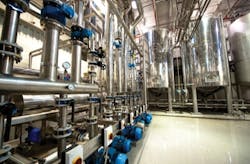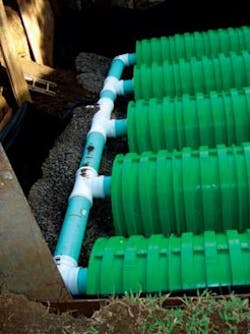University’s ‘Green’ ExpansionFeatures Sustainable Design
The University of Hawaii outside Honolulu was building a new 30,000 square-foot facility adjacent to its existing Biomedical Science Building to house the Center for Microbial Oceanography: Research & Education (C-MORE). C-MORE was established in 2006 by the National Science Foundation to explore how microbial diversity at the genomic level influences the structure and function of the largest biome, the global ocean.
Developed according to sustainable design principals and energy-efficient strategies, the building is currently targeting LEED Gold certification. “We are utilizing stormwater chambers on the project to help achieve LEED points SS 6.1 and, in conjunction with a water quality unit, SS 6.2,” explained architect Kimberly Polkinhorn, an associate with Group 70 International, which served as project manager. Stormwater chambers were needed to minimize stormwater flow to the storm drainage system and to allow the water to percolate back into the ground and recharge the water table.
The project is in Manoa, a rainy part of the island, so it was very important to minimize the amount of runoff going into the stormwater system, which is currently overtaxed. In addition, the island gets its fair share of tropical rain storms and must carefully monitor hurricane season from August through November.
The Solution
Engineers selected a system from Triton Stormwater Solutions for both its LEED credits as well as its stacking ability.
“The area where we needed to install the stormwater chambers was pretty tight due to existing electrical ducts and a tree that the university wanted to maintain,” explained Jared Mimura, engineer at Austin, Tsutsumi and Associates, which handled the civil infrastructure and grading for the site. “The Triton system allowed us to stack chambers in order to squeeze more storage into a smaller space.”
With systems such as Triton’s, potentially harmful runoff can be collected and stored underground, protecting the environment without the wasted space, cost and liability of a traditional retention pond and leaving natural green space.
“In addition, it acts as a filtration system through its innovative Main Header Row, which controls sediments and some pollutants,” said Joe Miskovich, president of Triton Stormwater Solutions. “Because of its strength and capacity, the system is scalable to any project and the chambers can be installed in a stacked configuration to reduce its footprint, making it more cost-effective and it provides greater value to the customer than other like systems.”
Figure 2: The lightweight construction and simple connection process of the chambers make for easy installation. A two-man team was able to install the chambers and manifold system in under four hours.
Located in the main header row, Triton’s debris and sediment collection system collect fines and debris and can be easily maintained by using a standard vacuum truck. Along with the system’s massive storage and gravel matrix with controlled discharge, it is an important asset for protecting water quality.
Figure 3: The large storage volume of the chambers made it possible to maximize stormwater storage in a small area, preserving mature trees and landscape during construction. The chamber rows can even be double-stacked when space is limited.
“This is a tremendous way to do both water quality and flow balancing, and can also affect water conservation by doubling as a cistern system for landscape irrigation,” explained Bill Wilson, an associate in environmental engineering at Carlile Macy in California. Wilson recently used Triton’s system at the LEED Platinum Sunset Idea House in Monterey, placing 25,000 gallons of capture/storage beneath the residential motor court for reuse in the xeriscaped landscape.
How It Works
Water enters the system through a standard manhole or pretreatment device. This allows pollutants such as hydrocarbons to be captured. Pretreatment best management practices can be as simple as deep sump catch basins and oil-water separators or as extensive as stormwater treatment devices.
Water gathers in the structure until it reaches a sufficient level to enter the Main Header Row, where remaining sediments are collected and a sediment floor, specially designed for ease of cleaning during a maintenance event, keeps them from clogging the base stone. Through this settling and controlled distribution process, a major portion of sediments carried by the stormwater is captured before the water is dispersed in open bottom distribution chambers. This makes the system easier and less expensive to maintain.
Figure 4: The chambers can be used with a variety of input strategies. While the Main Header Row is the most common entry point, a manifold system, such as the one used on the University of Hawaii project, can also be utilized.
“The system collects rain water and allows it to recharge the aquifer system just as it would have prior to the land being developed,” said Miskovich. “As water passes through the stone, sand and soil column, pollutants in the water are filtered out. Cleaner water is delivered back into the ground water aquifer network.”
The Installation
In October, the team began the installation of the system, which would store over 3,000 CF in a footprint of 45 feet by 80 feet by 13 feet deep.
First, the crew dug down to elevation and put down a six-inch base layer of stone. Next, the chambers were put in and the walls of the trench were lined with a class 2 nonwoven geofabric. The site was backfilled with stone up to twelve inches past the crown of the chambers and the geofabric was folded back and backfilled with material to the desired elevation, with the system requiring only 16 inches of cover.
The installation went very smoothly and was finished within four hours using two laborers.
“We have never done a system like this before,” explained David Itokazu, vice president of operation at J.J.S. Construction, the civil contractors on the project. “It was lightweight yet very sturdy and it was very easy to handle.”
Summary
Built with green technology soy resin, Triton’s stormwater chambers are completely modular to allow maximum flexibility in design and application. Using the system can help earn up to 18 LEED credits and meet Zero Discharge goals. Triton is also registered as a federally approved green carbon-neutral product and approved for use in all government-owned or -leased buildings and properties.
This particular project benefitted from the system’s flexible storage capability and illustrated how its environment-friendly properties are meeting a need in the construction industry.
About the Company
Established in 2007 and headquartered in Brighton, MI, Triton Stormwater Solutions manufactures the next generation of stormwater chamber management systems. Triton’s proprietary design and patented construction offer larger-capacity, lighter-weight, easier-to-install stormwater chambers made from environmentally friendly, manufacturing materials. For more information, please visit www.tritonsws.com.



